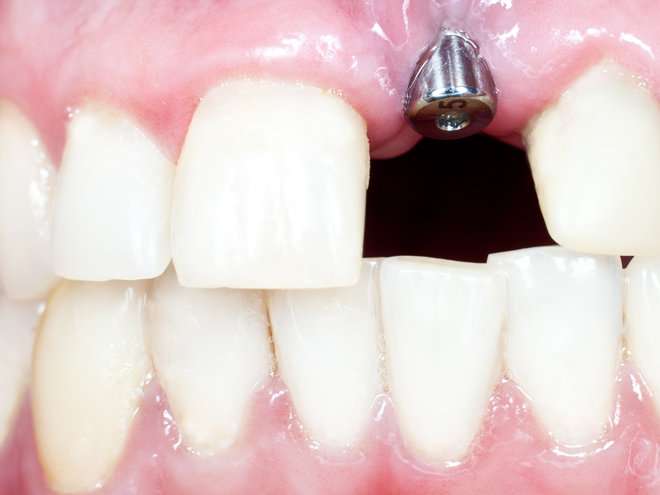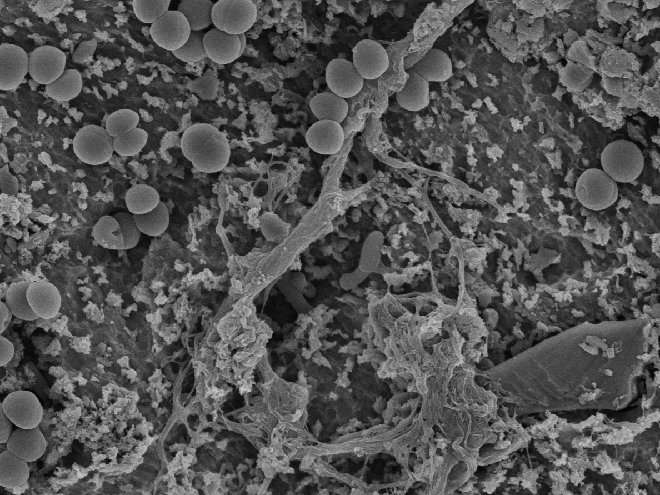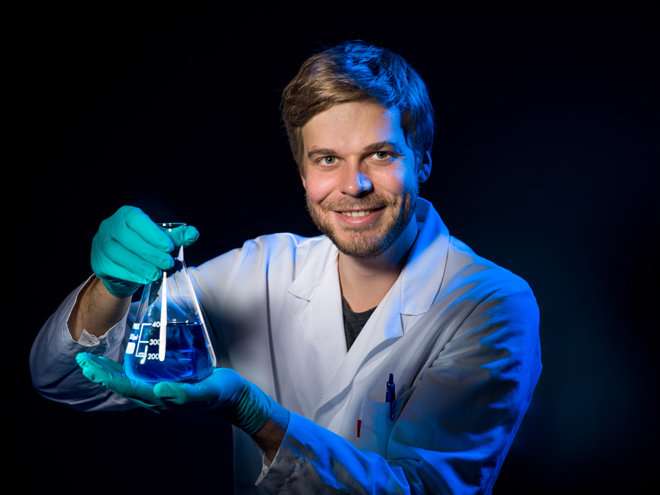Radical methods for infected implants

Molecules that are more often known for their potential to cause cancer may have a new, health-promoting role. Scientists are now discovering how these "radicals" may be used to prevent infections and promote the long-term success of dental implants.
Although dentists recommend that we keep our own teeth for as long as possible, increasingly many of us will eventually need one or more teeth replaced with titanium implants. This is especially true of the older generations.
However, dental implants often prove to be only a partially successful replacement. Bacteria can colonise the area around an implant. Bacterial infections around an implant can ultimately lead to loss of the bone supporting the implant, leaving the patient in great need of extensive treatment and overall poorer oral health as a result.
If the bone around an implant gets infected, there is a serious risk that the patient will need comprehensive restorative dental treatment and maintenance in order to maintain the function of the implant and restore the lost bone, if possible at all. Consequently, research into biomaterials that can be used to augment and guide the regrowth of lost bone has become a leading area of dental research.
Biofilms on implants
In order for a dental implant to function, it must be attached firmly to the jawbone. This means that the bone cells need to beat the bacteria in the so-called "race for the surface" of the implant. By winning the race, the bone cells will form new bone tissue around the implant, attaching the implant into bone.
However, it is often the bacteria that win the race. They form a biofilm, a thin layer of bacteria on the implant surface. – Biofilm is a smart way for bacteria to colonise surfaces; it makes the bacteria stronger, explains David Wiedmer, a research fellow at the Faculty of Dentistry at the University of Oslo. If the bacteria get the upper hand on the implant surface, the implant is prone to infection, with potentially serious consequences for the patient's health.

Infected implants are usually treated with antibiotics. – When bacteria form a biofilm, antibiotics often don't do the job because bacteria are protected within a biofilm. In the light of the dramatic increase in antibiotic-resistant bacteria, there's an urgent need to find alternative treatments, says Wiedmer, who is originally a mechanical engineer. He started looking at free radicals as an alternative. These unstable molecules can cause stress in bacteria, which in turn can create an antibacterial effect.
Highly reactive radical molecules
Free radicals are unstable molecules because they have an unpaired electron. Thus, they are always looking for another electron to pair with. Free radicals are known to be harmful and pathogenic molecules that can cause changes in DNA, which in turn can create mutations that may lead to cancer. Wiedmer's hypothesis was that the reactivity of free radicals could also be used to kill bacteria.
He based his idea on a known chemical process, photocatalysis: When titanium dioxide (TiO2) is exposed to ultraviolet light, as found in sunlight, in the presence of oxygen, the surface cleans itself of any organic dirt, breaking it down into water and oxygen. This cleaning process is based on the formation of free radicals and it is the same reaction that is used in solar cells to produce energy.
Dental implants also have TiO2 on their surface. Almost all dental implants are made of titanium, and TiO2 is created when titanium comes into contact with oxygen from the air or blood, e.g. when an implant is inserted into the mouth.
Dark catalysis for treatment and prevention
However, it is difficult to produce photocatalytic reactions on implants. This is because of the obvious problem of adding the necessary sunlight into the reaction between the TiO2 on the implant surface and the oxygen in the blood when the implant is already inserted in the bone in your jaw.

For this reason, Wiedmer has studied treating bacterial infections on implants using a method he calls "dark catalysis". By combining TiO and hydrogen peroxide (H2O2), instead of water and sunlight, he achieves a similar effect as photocatalysis. When H2O2 is added onto an implant covered by a layer of TiO2, free radicals are also released—but this time in the dark.
Given the strong antibacterial properties of the produced free radicals, Wiedmer investigated dark catalysis on TiO2 in two different biomedical applications. The first tested application was to treat an existing infection around an implant. His research also examined whether the method could have a preventive effect on "scaffolds", porous frameworks that can be inserted into the jawbone to support and guide bone cells to grow and form "new" bone.
Promising, but difficult to implement
Wiedmer has reason to be optimistic that one day it might be possible to control bacterial infections around dental implants and prevent them more easily. His studies showed that dark catalysis is a promising method to treat infections as it creates radicals that help fight bacteria.
The research also indicated that dark catalysis could be further developed and applied to bone scaffolds. These scaffolds support the regeneration of lost bone tissue into which implants can be then inserted. In his studies, Wiedmer found that radicals formed by dark catalysis could prevent bacteria from colonising the surface of porous TiO2 scaffolds.
"The preventive effect is actually more important than their use in treating pre-existing infections. After all, implants that cause trouble due to infections can, as a last resort, be extracted. But you can't easily remove a porous scaffold once bone has already grown into the pores of the scaffold," he explains.
However, there is much more research to be done before dark catalysis can be applied in dental surgeries. Wiedmer could not conclusively rule out the possibility that the radicals might also damage cellular DNA while fighting the bacteria. – I hope this new strategy of using free radicals to kill bacteria can help us to find alternative treatments to antibiotics. Although there's still some way to go, including clinical trials, this project might eventually shed some more light into the dark, Wiedmer says with a grin.
More information: David Wiedmer et al. Oxidative power of aqueous non-irradiated TiO 2 -H 2 O 2 suspensions: Methylene blue degradation and the role of reactive oxygen species, Applied Catalysis B: Environmental (2016). DOI: 10.1016/j.apcatb.2016.05.036
David Wiedmer et al. Antibacterial effect of hydrogen peroxide-titanium dioxide suspensions in the decontamination of rough titanium surfaces, Biofouling (2017). DOI: 10.1080/08927014.2017.1322585
Journal information: Applied Catalysis B: Environmental
Provided by University of Oslo


















